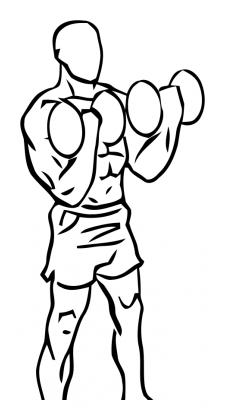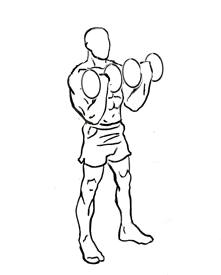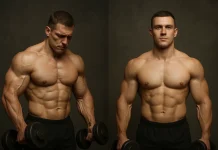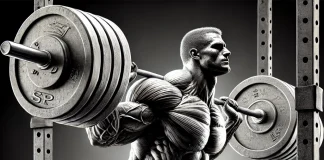Last Updated on September 30, 2014
Having strong, defined biceps, there’s no better exercise than the classic biceps curl with dumbbells. This timeless move not only helps build the biceps but also strengthens the surrounding muscles, leading to better overall arm strength. In this comprehensive guide, we’ll break down everything you need to know about the dumbbell biceps curl, from how to perform it correctly to the different variations and benefits it offers. Whether you’re a beginner or an experienced lifter, this guide has something for everyone.
What is a Dumbbell Biceps Curl?
A dumbbell biceps curl is a resistance training exercise primarily targeting the biceps brachii, the muscle responsible for the “flexed arm” look. It’s one of the most common exercises you’ll see in any gym, but that doesn’t make it any less effective. Performing biceps curls with dumbbells allows for a natural range of motion and helps reduce muscle imbalances by forcing each arm to work independently.
Benefits of Dumbbell Biceps Curl
Why should you include dumbbell biceps curls in your routine? Here are some of the key benefits:
Increased Arm Strength: The biceps curl focuses directly on the biceps, helping to increase muscle strength and endurance over time. This improves your ability to perform daily tasks like lifting objects, pushing, and pulling.
Muscle Growth (Hypertrophy): For those looking to increase muscle mass, biceps curls are a fundamental exercise. By performing curls with controlled tension, you stimulate muscle fibers that promote growth, leading to larger, stronger arms.
Enhanced Muscle Definition: If you’re aiming for well-defined arms, dumbbell curls can help you tone your biceps. Combining this exercise with a well-balanced fitness routine and diet will lead to visible muscle definition.
Improved Joint Health: Regular strength training with proper form strengthens tendons and ligaments around the elbow and shoulder joints, reducing the risk of injury and improving joint function.
Versatility: Dumbbell biceps curls can be done almost anywhere – whether you’re in the gym, at home, or on the go. You only need a pair of dumbbells to get started.
How to Perform Dumbbell Biceps Curl Properly
One of the biggest mistakes people make when doing biceps curls is improper form. Incorrect form can reduce the effectiveness of the exercise and increase the risk of injury.
Follow these steps to ensure you’re performing the biceps curl correctly:
Step-by-Step Instructions:
Starting Position: Stand with your feet shoulder-width apart. Your knees should be slightly bent, and your core engaged (abs drawn in). This stance helps provide stability and prevent lower back strain.
Grip and Posture: Hold a dumbbell in each hand with your palms facing up (a supinated grip). Your arms should hang at your sides, fully extended.
Lock Elbows in Place: Keep your elbows close to your sides and locked in place. They should not move during the exercise. This ensures that the biceps are doing the work rather than relying on momentum or other muscle groups.
The Curl Motion: Slowly curl the weights upwards towards your shoulders by flexing your elbows. Focus on squeezing your biceps at the top of the movement. Ideally, your forearms should come into contact with your biceps at the peak of the curl.
Controlled Descent: Lower the dumbbells back to the starting position in a controlled manner. This is crucial – the lowering phase (eccentric phase) is just as important as the lifting phase for muscle growth.
Repeat: Aim for 8 to 12 repetitions per set, depending on your fitness level and goals. For hypertrophy (muscle growth), aim for 3-4 sets with a weight that challenges you by the last few reps.
Important Form Tips:
- No Swinging: Avoid swinging your body to lift the dumbbells. This takes the tension off your biceps and engages other muscles, reducing the effectiveness of the exercise.
- Keep Your Core Engaged: Throughout the movement, maintain a tight core to stabilize your body and avoid excessive movement.
- Don’t Lock Your Knees: Keep a slight bend in your knees to protect your joints and maintain balance.
- Breathe Properly: Exhale as you lift the dumbbells and inhale as you lower them. Proper breathing helps with oxygen delivery to the muscles and keeps you focused.
Common Mistakes and How to Avoid Them
When it comes to lifting, bad habits can easily form, especially when you’re eager to increase weight or speed through your reps. Here are a few common mistakes people make when doing dumbbell biceps curls, along with tips on how to correct them:
Using Momentum: Swinging your body to lift heavier weights might seem like you’re getting stronger, but in reality, it takes the focus off your biceps. Instead, use a weight that you can control and keep your form strict.
Elbow Movement: Allowing your elbows to drift away from your sides reduces the effectiveness of the biceps curl. Always keep your elbows stationary to maintain tension on the biceps.
Half Reps: Not completing the full range of motion can cheat your muscles out of growth. Make sure you fully extend your arms at the bottom and bring the dumbbells all the way up to your shoulders during the curl.
Lifting Too Fast: Speeding through your reps might seem like a way to get the job done faster, but slow and controlled movements are more beneficial for building muscle and strength. Take your time and focus on muscle contraction.
Variations of Dumbbell Biceps Curl
Once you’ve mastered the standard biceps curl, it’s a good idea to switch things up to keep your workouts fresh and challenging. Here are some variations to try:
Hammer Curl: Instead of keeping your palms facing up, rotate your wrists so that your palms face each other throughout the movement. This targets the brachialis muscle, which lies beneath the biceps, adding thickness to your upper arm.
Concentration Curl: This variation isolates the biceps even more. Sit on a bench with your legs apart, place your elbow on the inside of your thigh, and curl the dumbbell towards your shoulder. It’s great for emphasizing the peak of the biceps.
Incline Dumbbell Curl: Perform biceps curls while sitting on an incline bench. This position places the biceps in a stretched position, increasing muscle activation and promoting greater muscle growth.
Zottman Curl: Combine a traditional curl with a reverse curl to hit both the biceps and the forearms. Curl the dumbbells up with a supinated grip, then rotate your wrists to a pronated grip (palms down) before lowering the weights.
21s: Perform 7 reps from the bottom of the movement to halfway up, 7 reps from the halfway point to the top, and finish with 7 full-range reps. This method is a great way to shock the biceps into growth.
Incorporating Biceps Curls into Your Workout Routine
Biceps curls are typically included in arm or upper-body workouts. However, the frequency with which you perform them should depend on your training goals. Here’s how to structure your biceps training based on different objectives:
For Muscle Growth (Hypertrophy):
To maximize muscle growth, aim for 8-12 reps per set with 3-4 sets. Train your biceps 2-3 times per week, making sure to give them at least 48 hours of recovery between sessions. Pair biceps curls with other exercises like hammer curls, chin-ups, and preacher curls to hit the biceps from multiple angles.
For Strength:
If your goal is to increase strength, focus on heavier weights with fewer reps (around 4-6 per set) and 3-5 sets. Because biceps curls are an isolation exercise, they shouldn’t be the foundation of your strength training but can complement compound movements like rows or pull-ups.
For Endurance:
To build endurance, use lighter weights and aim for higher reps (15-20 per set). This will help improve your muscles’ ability to perform over extended periods.
Complementary Exercises for Better Arm Development
For well-rounded arm development, biceps curls should be part of a balanced workout plan that also targets other key muscles. Consider adding these exercises to your routine:
- Triceps Dips: Strengthens the triceps, the muscles opposite the biceps, which contribute to overall arm size.
- Pull-Ups: A compound movement that targets the biceps, shoulders, and back for complete upper body strength.
- Cable Curls: Provides continuous tension throughout the range of motion, which is excellent for muscle growth.
- Preacher Curls: Isolates the biceps even more, making them work harder with less help from other muscles.
Final Thoughts
The dumbbell biceps curl is an essential exercise for anyone looking to improve arm strength and muscle size. By mastering the correct form and incorporating variations into your routine, you’ll be well on your way to achieving those strong, defined arms you’ve always wanted.
Remember, the key to success with any exercise is consistency and progression. Start with a weight you can handle with proper form, and as you get stronger, gradually increase the resistance








